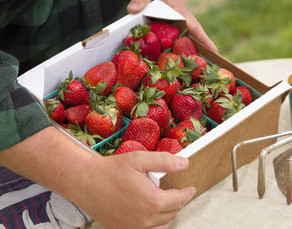Growing up in the Willamette Valley in Oregon “The Mighty Strawberry” was a fruit that we all knew! Many of us began at an early age to work in the strawberry fields and that often continued well into high school. Yes, we ate more than we probably should have! More than one early childhood romance began in those strawberry fields! Oh, how sweet and luscious were those crimson red berries. Not at all like the flat tasting, juiceless berries in the grocery stores today.

A LITTLE HISTORY OF THE MIGHTY STRAWBERRY
It seems that the first strawberries were discovered in Rome around 234 BC. Their first use seems to have been as a medicine. Interesting, how many of our fruits and vegetables started out as herbal medicines and tonics! Wild strawberries, of different varieties, appear to have grown in several parts of the world very early. Europeans had an early, apparently tasty, very small variety. The American strawberry plant was superior to the native European plant and early ships returning to Europe from North America began taking back the more robust plants from the new continent. During the 1700s many varieties were developed and grown both in Europe and North America. Because of its delicious taste and the many ways it could be used and preserved it became very popular. Today, China is the worlds leading strawberry producer (3,041,560 tons) with the United States being second (1,302,743 tons). Mexico comes in third with 681,965 tons. Some of the best strawberry jams and preserves are made in Turkey which produces about 448,162 tons of the fruit.

STRAWBERRIES CAN BE USED SO MANY DIFFERENT WAYS
Strawberries are packed with nutrition! The average US citizen consumes about five pounds of these wonderful berries each year according to the USDA. They are an antioxidant goldmine! Some of the antioxidants found in the strawberry are vitamin C, and the carotenoids lutein and carotene. The average strawberry yields the following for each 100 g. Calories, 32, Fats .3 g., Sodiun 1 mg, Fiber 2 g, Sugar 4.9g, Potassium 153 mg, carbohydrates 7.7g, Protein .7g. Fresh strawberries are the best but because they are so tasty they also are a fine fruit to store as a dried berry. Dried strawberries are often added to morning breakfast cereal, pastries, and various recipes. The strawberry can be frozen, canned, freeze-dried and used in jams and jellies. Fresh strawberries can be sliced into salads, cutting them small and blending them into yogurt or dropping them into your mixer as you make a smoothie! There are so many ways to use this amazing little fruit!

STRAWBERRIES CAN BE GROWN ANYWHERE
Strawberries are extremely versatile. They can be grown commercially in huge acreages or in very small home garden plots. Strawberries today are often grown in large greenhouses with controlled ventilation and ground nutrients. In my Grandmothers’ WWII Victory Garden she had two long rows of bushes she cared for year after year with kitchen compost and chicken manure that she carefully worked into the soil. Oh, how delicious were those berries! I have seen strawberries growing in pots on the patio of friends homes. Home grown and cared for strawberries are much more delicious than the berries in grocery stores that have traveled miles in semi-trucks to arrive at market. Farmer’s Markets often have berries that have been grown by the farmers themselves. One essential for good juicy berries is adequate water. Once you have tasted a home-grown berry that ripened to its fullness on the vine you will never want to return to the flat tasting, juiceless berries that so many know today!
To learn more about health and nutrition, check out my Facebook page: https://www.facebook.com/philswellnesswagon
Thanks for visiting. Please leave any questions or comments.
Your nostalgic account of “The Mighty Strawberry” brings forth a heartwarming connection to both your personal history and the rich heritage of this luscious fruit. Your recollections of childhood romances and working in the strawberry fields paint a vivid picture of the significance these berries held in your community. The historical insight you provide, tracing the strawberry’s journey from medicinal use to its global popularity, is fascinating. Your emphasis on the nutritional value of strawberries as an antioxidant powerhouse, along with their versatility in various culinary applications, showcases the depth of your knowledge. Your advocacy for homegrown strawberries and their unmatched taste resonates strongly, reminding us of the joy that comes from a fruit ripened to perfection on the vine. Thank you for sharing this delightful and informative piece!
Ashley, you write wonderfully well! I do hope you are taking advantage of that skill!
I really appreciate the history revealed in this article. I can’t, unfortunately, grow strawberries to save my life. I did not know they were such a worldwide fruit. I always thought they were a North American plant but it only makes sense that they are cropped in many countries. I try to buy local produce as often as I can but it’s harder and harder these days. May be I’ll work harder with my own strawberries.
Deedee
Sorry to hear they are hard for you to grow. How about a local Farmers Market?